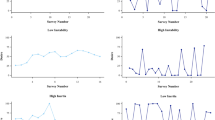Abstract
This article looks at two of the major issues associated with the development of condition-specific quality of life measures. The first issue is the process of conceptualization. The importance of conceptualization to developing sound questions and instruments is evaluated, and the need to utilize multiple perspectives in the conceptualization process is discussed. The second issue addressed is fundamentals of writing survey questions. Questions from a range of sexual function questionnaires are presented and discussed relative to seven basic guidelines associated with question and response category development.



Similar content being viewed by others
References
Rockwood T, Constantine M (2005) Demographic and psychosocial factors. Understanding health care outcomes research. Kane RL, Gaithersburg MD, Aspen
Rockwood T (2005) Quality of life with urinary and fecal incontinence. Urinary and Fecal Incontinence: An Interdisciplinary Approach. In: Becker HD, Stenzl A, Wallwiender D, Zittel TT (eds) Springer, Berlin, pp 369-384
Rockwood TH (2004) Incontinence severity and QOL scales for fecal incontinence. Gastroenterology 126(1 Suppl 1):S106–S113
Rogers RG, Kammerer-Doak D, Villarreal A, Coates K, Qualls C (2001) A new instrument to measure sexual function in women with urinary incontinence or pelvic organ prolapse. Am J Obstet Gynecol 184(4):552–558
Groves RM (1989) Survey errors and survey costs. Wiley, New York
Dillman DA (2007) Mail and internet surveys: the tailored design method. Hoboken, Wiley
Payne SLB (1951) The art of asking questions. Princeton University Press, Princeton
Fowler FJ (1995) Improving survey questions: design and evaluation. Sage, Thousand Oaks
Sudman S, Bradburn NM (1996) Thinking about answers: the application of cognitive processes to survey methodology. Jossey-Bass, San Francisco
Willis GB (2005) Cognitive interviewing: a tool for improving questionnaire design. Sage, Thousand Oaks
Maaita M, Bhaumik J, Davies AE (2002) Sexual function after using tension-free vaginal tape for the surgical treatment of genuine stress incontinence. BJU Int 90(6):540–543
Rust J, Golombok S (1985) The handbook of the Golombok–Rust inventory of sexual satisfaction. NFER-Nelson, Windsor
White CB (1982) A scale for the assessment of attitudes and knowledge regarding sexuality in the aged. Arch Sex Beh 11(6):491–502
Schwarz N, Sudman S (1992) Context effects in social and psychological research. Springer-Verlag, New York
Sirken MG, Herrmann DJ (1999) Cognition and survey research. Wiley, New York
Tourangeau R, Rips LJ (2000) The psychology of survey response. Cambridge University Press, Cambridge
Vail-Smith K, Durham TW et al (1992) A scale to measure embarrassment associated with condom use. J Health Ed 29:209–214
Hochstim JR (1967) A critical comparison of three strategies of collecting data from households. J Am Stat Assoc 62(319):976–989
Biemer PP, Groves RM (1991) Measurement errors in surveys. Wiley, New York
Stuber J, Galea S et al (2008) Smoking and the emergence of a stigmatized social status. Soc Sci Med 67(3):420–430
Bradburn NM, Sudman S (1979) Improving interview method and questionnaire design. Jossey-Bass, San Francisco
Rockwood TH, Sangster RL (1997) The effect of response categories on questionnaire answers: context and mode effects. Sociol Methods Res 26(1):118–140
Schwarz N, Hippler H-J et al (1985) Response scales: effects of category range on reported behavior and comparative judgments. Public Opin Q 49:388–395
Taylor JF, Rosen RC, Leiblum SR (1994) Self-report assessment of female sexual function: psychometric evaluation of the Brief Index of Sexual Functioning for Women. Arch Sex Beh 23(6):627–643
Alwin DF, Krosnick JA (1991) The reliability of survey attitude measurement: the influence of question and respondent attributes. Sociol Methods Res 20(1):139–181
Schwarz N, Knauper B et al (1991) Rating scales: numeric values may change the meaning of scale labels. Public Opinion Quarterly 55(4):570–582
Alwin DF (1997) Feeling thermometers versus 7-point scales: which are better? Sociol Methods Res 25(3):318–340
Schuman H, Presser S (1996) Questions and answers in attitude surveys: experiments on question form, wording, and context. Sage, Thousand Oaks
Lyberg L, Biemer P (1997) Survey measurement and process quality. Wiley, New York
Conflicts of interest
None.
Author information
Authors and Affiliations
Corresponding author
Rights and permissions
About this article
Cite this article
Rockwood, T., Constantine, M. Item and instrument development to assess sexual function and satisfaction in outcomes research. Int Urogynecol J 20 (Suppl 1), 57–64 (2009). https://doi.org/10.1007/s00192-009-0842-9
Published:
Issue Date:
DOI: https://doi.org/10.1007/s00192-009-0842-9




